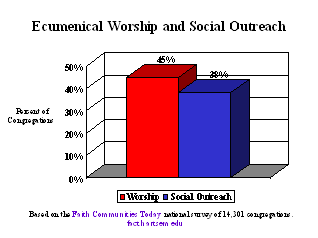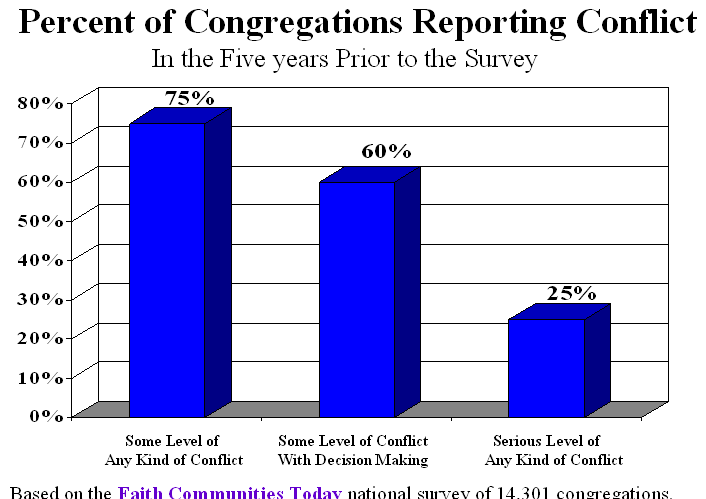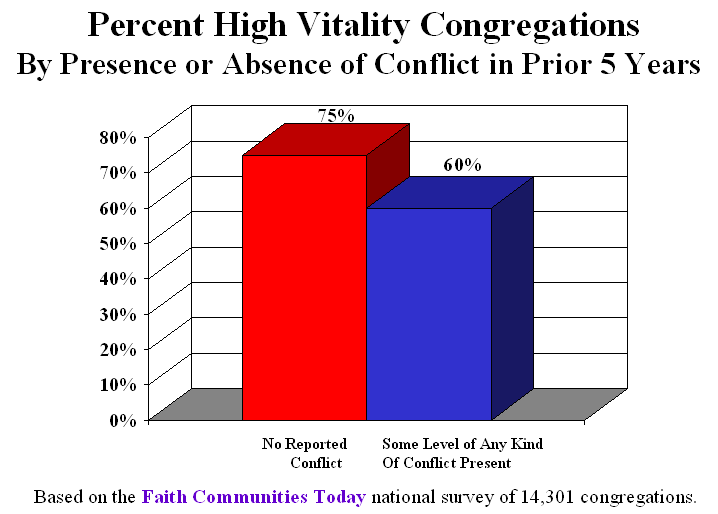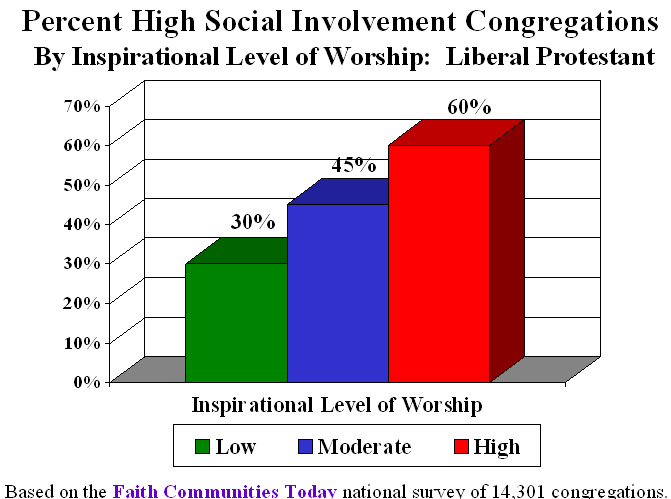Four Mega-Trends Changing America’s
Religious Landscape
by David A. Roozen
Presented at the Religion Newswriters Association Annual Conference, Boston, MA September 22, 2001
It is always a pleasure to share the podium with George Gallup Jr. I began tracking national religious trends using public opinion survey in the early 1970s, and as at least a few of you may recall, prior to Jimmy Carter’s first presidential campaign virtually the only national polling organization that regularly asked about religion was the Gallup Poll. Indeed, the Gallup organization’s interest in and habit of polling about religion goes all the way back to its founding in the early 1930s. Guess who knows this data better than anyone else, and who has continued, and even intensified the Gallup Organization’s tracking of religion in America? George Gallup, Jr.! A great resource to keep on your rolodex (or perhaps I should say, your palm pilot).
Given George’s presense today to represent the wonderful collection of Gallup Poll trend data on religion, it seemed advisable for me to take a slightly different tack. So rather than starting and staying with a very specific collection of national trend data, I want to step back into a more reflective and interpretive mode to put forth my sense of the four religious mega-trends most dramatically changing the foundations of Faith Communities in America today. The identification of these four trends is, therefore, based more on the cumulated perspective of my 30 years of studying religious change, than on any one identifiable set of data. Nevertheless, I’ve spent my entire career testing understanding with hard data, so rather than asking you to take my four mega-trends purely on faith, I also want to show how they are reflected in the empirical reality of religion today. To do this I will be drawing examples from the recent, Faith Communities Today survey of 14,301 congregations.
This national study, know as FACT for short, is less than a year old. It was a huge cooperative, interfaith effort including participation by 41 denominations and faith traditions – Mormon to Muslim, Baptist to Bahai to Black Church, Unitarian Universalist to Southern Baptist, Christian Orthodox to Assemblies of God, Catholic, Jewish and Old Line Protestant. If you are not aware of this study, or want more details, please check out the study’s website – fact.hartsem.edu.
The first trend I want to highlight was featured in the original March 13, 2001 release of the FACT data, but its salience has escalated untold fold with the events of the last two weeks [i.e., since September 11]. It is the changing face of American religion in general and in particular the shift from an:

Prior to September 11, the continual flaring of denominational fights, the high profile of the mega-churches, the looming Olympics in the Mormon heartland, and the ambiguous energy behind charitable choice (to name but a few examples) kept your lives as religion news writers interesting, if not exciting. On September 11, enhancing public understanding of the changing nature of religion in America became a national priority -- and also, in this case tragically, a unique opportunity. Not only did the depth of our nation’s religious grounding play out in the explicitly religious character of our national mourning and search for comprehension. But perhaps more importantly, no American who picked up a newspaper, hit the web or even glanced at television could escape an incredible contraction. On the one hand, there were the bursts of hate and vilification of everything Islamic. On the other hand, nearly every major worship service, most notably those including the President of the United States, were not only ecumenical in nature, but interfaith. And beyond our traditionally understood melting pot of Protestant, Catholic and Jew, the services intentionally included Islam.
The Democratic presidency of Jimmy Carter will long be associated with our country’s rediscovery of evangelical, "born again" Protestantism. With equal irony, it will likely be that the Republican presidency of George W. Bush III is long remembered as marking the official acknowledgement and affirmation of Islam’s addition to America’s interfaith reality.
There has been a Muslim presence in the United States for over two centuries, to be sure earliest evidence traceable to African slaves. And that presence has been one of the most rapidly growing segments of our religious mosaic over the last quarter century due to a combination of world events, changes in our immigration laws and the ascendance of Islam in our African American communities. But this growth and change has come with considerable ambivalence and -- at best -- quiet tolerance and avoidance. Today, the ambivalence is, if anything, greater than ever. But this is because, at least in part, our public consciousness has had to acknowledge in the most powerful way in our history that the religious liberty-in-diversity that American’s cherish has moved from ecumenical Christian to interfaith, and that this American, interfaith consciousness will forevermore include Islam. [Or, for the more academically nuanced, one would say that our nation’s public religious self-perception has moved from Judeo-Christian to Abrahamic.]
Will this new consciousness quickly give way to embrace, or at least increased experiences of interfaith cooperation? The unprecedented nature of September11 makes it impossible to predict with any certainty. However, the FACT data on the ecumenical and interfaith involvement of American congregations suggests two things.
- Ecumenical Worship and Outreach
The first is that the level of ecumenical cooperation among Christian congregations – either in terms of joint worship or cooperative social ministry – is lower than one might expect. This level of around 40% would seemingly set the high side mark of likely regularized interfaith cooperation among congregations in the foreseeable future.
- Interfaith Worship and Outreach

Second, the FACT data shows, perhaps equally surprisingly low levels of interfaith cooperation – only around 7% of American congregations indicating any interfaith involvements in the year prior to the survey. Such a low thresh-hold suggests that an increase is almost inevitable, but also highly unlikely to come close to the 40% high side marker.
My first mega-trend points to the increasing diversity in the United States across religious traditions. My second trend focuses on the increasing diversity within individual religious denominations or faith groups. I call it a shift from the:
- Prophetic to the Political
A few of you may recall when national denominational conventions seldom made social pronouncements—at least church historians tell me there was such a time. Some of you will recall the denominational unanimity and confidence of prophetic pronouncements and actions on race beginning in the mid-to-late 1960s. Most of you are aware that the pronouncement process has since grown to a taken-for-granted ritual for a growing spectrum of denominations and faith groups. And, I trust that, all of you are aware that over the past decade and a half the denominational unanimity and confidence of the 1960s has continually degenerated into as contested and bitterly partisan a process as anything happening in Washington D.C.
American denominations and faith groups have become more internally diverse. Previous minority movements within any particular denomination have used new found skills for political organizing and have used the liberally derived ideology of pluralism with its implicit affirmation of difference, to forcefully reclaim their participation in the democratic national decision making processes typical of most denominations. And since religious fights typically are fought over differences in religious authority it is difficult to find a common, higher authority to which to appeal ones’ differences. So rhetoric gets hot, common ground becomes impossible to find, and either political power or political compromise is all that is left to carry the day – neither of which lends itself to a credible prophetic presence. The politicization of national religious decision making is perhaps most visible in those large and more publicly transparent denominations such as the United Presbyterians, United Methodists and Southern Baptists. But rest assured that, although publicly muted, it is just as present in such traditions as, for example, the Assemblies of God, Missouri Synod Lutheran, Reformed Church in America and National Baptist Convention.
It is hard to imagine the when or why of an end to partisan contests in national politics (a strong external threat/crusade, perhaps being the one exception). And it is equally hard to imagine the when or why of an end to the politicization within American religion. But the FACT data points to two reasons why, at least at the congregational level, the political process of contesting differences should be a concern.

Three out of every four congregations (75%) indicate at least some conflict in the five years prior to the survey; 60% report some conflict with in regard to decision making; and 25% report at least some kind of serious conflict.
More importantly, it is absolutely clear that conflict can be a major detriment to vitality – at least in the short-term.

The third mega-trend to which I want to call your attention a call the is the shift in religious authority and vitality from:
What I mean by this may take a moment or two of explanation, but I hope you hang in there with me because I believe that this is the most profound and foundational of the religious transitions affecting America.
It is not uncommon – indeed it may be most typical – for persons to think of religion as a collection of beliefs and doctrines, most closely tied to if not directly drawn from a sacred Scripture. The beliefs, doctrines and scripture are cognitive and objective. Worship in such a tradition tends to emphasize preaching and the style of preaching is expository. This is what I mean by a religious orientation grounded in THE WORD.
In contrast, we are becoming increasingly aware that many persons practice religion more in terms of a liturgical or personal relationship to God. Such an approach is more experiential and subjective. Worship in such a tradition emphasizes ritual and/or prayer and the gifts of the spirit. If preaching is included it tends to be narrative. This is what I mean by a religious perspective oriented to THE SPIRIT.
One finds evidence for the current shift from WORD to SPIRIT in, for example:
- The seekership in Wade Clark Roof’s baby boom monograph, A Generation of Seekers.
- In Marler and Roozen’s use of Gallup survey data to connect the societal shift from an objective to a subjective locus of authority to the increasing phenomena of "church as choice" (Chapter in Roozen and Hadaway, eds, Church and Denominational Growth).
- In the worry of Evangelical Christian scholars about a shift from God as Judge to Jesus as friend
And one can make sense of the reasons for this shift when one recalls Robert Bellah’s engaging elaboration of the rise of "expressive individualism" in his well know book, Habits of the Heart. And one can make sense of the reasons for this shift when one reads in just about any "Post-Modern" treatise about the breakdown of Grand Narratives and the relativizing of all objective truth claims.
In the FACT data this shift from WORD to SPIRIT helps us understand why we find higher levels of congregational vitality in more expressive than cognitive denominational families.
- Vitality by Expressive Cognitive

Even when we separately examine Old-line and Conservative Protestantism, for example, we find higher levels of vitality among the more expressive denominations (e.g., Episcopal and Unitarian Universalist with old-line Protestant) than among the more cognitive (e.g., Presbyterian and UMC with old-line Protestantism). But the graphic also cautions that one cannot write off those traditions invested in the WORD. There may be a momentum shift toward the SPIRIT, but there is plenty of residual strength within the more cognitive traditions (and every tradition has some investment in both) – certainly making for enough potential tension to keep the religious news interesting.
The final mega-trend I see is a shift in attention from:
This trend is particularly located within and salient to Old-line Protestantism, but perhaps can stand as healthy reminder to other traditions as they are tempted by charitable choice dollars. American Protestantism, with a special debt of thanks or regrets to its Calvinist roots, has long been distinguished by its "activism," which in religious language translates to its strong bias toward mission. Historically this meant evangelism, with social concern taken care of informally among a faith communities’ members or through the religious formation of individual conscience or later through national denominational or ecumenical agencies. And within a contemporary world in which virtually every congregation is involved in or financially supporting some kind of social ministry program, it is a little difficult to think that congregational involvement in social ministry programs is largely a 20 Century development – a conflux of late nineteenth century urbanization and the social gospel movement, which got kicked up a notch in the post WW II period as religious groups followed the government into a vast expansion of programmatic delivery of "welfare" services. Combined with the strong prophetic voice that Old-line Protestantism claimed beginning in the mid-1960s, it became quite common for theologians and denominational leaders to loudly proclaim that "the purpose of the church is mission." Behind such bold proclamation, it was relatively easy to forget or to take for granted that mission was a response to God’s grace, and that therefore worship, as both a vehicle of and praise for God’s grace, might be even more foundational than mission. Or, as some commentators have put it, in taking worship for granted old-line Protestantism tended to forget that the empowerment of worship might be a pre-condition for one’s commitment to mission Its not that old-line Protestants stopped worshipping. Rather, worship got put on automatic pilot, and for 30 years or so its forms were largely stuck in the 1950s. Unfortunately for old-line Protestantism, this inattention came at the exact same time as a profound, baby-boomer-carried change in American values, style and appreciations; and you all are well aware of the resulting old-line Protestant declines.
But that’s old news. The current news is that old-line Protestantism has rediscovered worship! Whether it is because social mission is now so pervasive and social justice so contested that there is need and opportunity to redirect one’s attention to worship; or whether it is because old-line Protestantism can no longer ignore the apparent success of seeker services and more expressive denominational traditions; or whether it is because the old-line has finally been able to translate its finally tuned sense of the necessarily contextual nature of international mission to a sense of necessarily generational contextualization of domestic concerns, we really don’t know yet. But there is enough experimentation and change going on in old-line Protestant congregations that it has become a major source of conflict. Indeed you have probably heard the rhetoric raised to the level of "worship wars. "
The FACT survey shows, for example, that almost a third of liberal protestant congregations had significantly changed their style of worship in the five years prior to the survey; and that sixty percent of these had at least some conflict.
Where it will all go, we don’t know. But I tend to think it is good news for old-line Protestantism, suggesting that it has not totally lost the adaptive capacity which has kept religion more vital in the United States than any other industrial country. And the FACT data suggests why I think it should be taken as good news. Any of you who have seen the FACT report, are hopefully well aware of the strong relationship between contemporary worship and membership growth – across all denominational families, so I won’t repeat that here. But the FACT data also shows more generally that the more inspirational a congregation’s worship the higher the congregation’s vitality, across all Christian families.
- Inspirational Worship by Vitality

And particularly good news for traditions heavily invested in social ministry, the FACT data shows that the more inspirational the worship the more a congregation is involved in social ministry.
- Inspirational Worship by Social Ministry

So there you have it, four dimensions of the profound change in American religion that should be keeping your jobs interesting:
- Increasing diversity across religious groups
- Increasing diversity within religious groups
- Both of which contribute to an environment more conducive to the more expressive, subjective and spiritual sides of religious expression
- And all of which are prompting religious groups to reemphasize and reconsider their primary business of and source of strength in the worship of God
Thank you 
|
